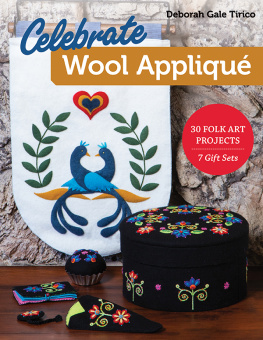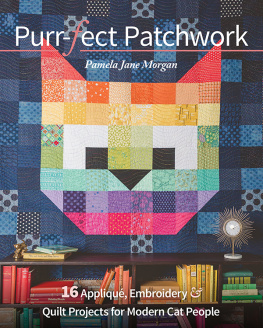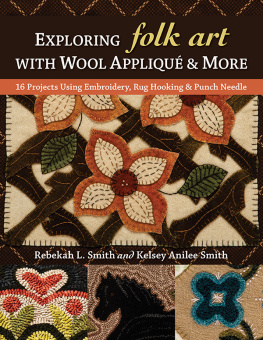Publisher: Amy Marson
Creative Director: Gailen Runge
Art Director / Cover Designer: Kristy Zacharias
Editor: Lynn Koolish
Technical Editors: Susan Nelsen and Alison M. Schmidt
Book Designer: Katie McIntosh
Production Coordinator: Jenny Davis
Production Editor: Katie Van Amburg
Illustrator: Tim Manibusan
Photography by John Doughty | Spy Photography, unless otherwise noted
Published by C&T Publishing, Inc., P.O. Box 1456, Lafayette, CA 94549
Dedication
I dedicate this book to my mum and dad, who were amazing parents and were always proud of my accomplishments.
Acknowledgments
I would like to thank:
My family, for their patience and supportespecially my husband, George, who, among other things, cooks for me every night while I carry on working; my children, Taylor and Isaac, who happily throw in comments when I ask for their opinion on my designs; my sisters, Annette and Gwennyth, who introduced me to quilting and are always proud of what I do; my brother Garry, who runs my website; and Jenn, who always kindly offers advice and opinions when asked.
My many friends with whom I have far too little time to be withespecially Narelle, who encouraged me to start my business, and Nola, who always listens.
Kathy Doughty, who has given so much. I have no doubt that I wouldnt be where I am without her support, inspiration, and encouragement.
The talented staff at Material Obsession, who make my life fun and who inspire me every day.
John Doughty, who did the photography. I had total faith that he would make my quilts look amazing.
All the students who take my classes. I do this for themthey inspire me and make what I do worthwhile.
Everyone who makes my quilts and buys my patternswithout them, I couldnt carry on doing this as my job.

T he projects in this book combine a variety of fabrics, including cotton solids and prints, linen, and wool. By combining different patterns and textures, and with a touch of fun and imagination added in, you can achieve stunning, contemporary projects. You cant help but have fun, because the techniques are simple and easy to achieve for all lovers of stitching. Working with color is always cheery and good for the soul. You can even add extra embellishment to the designs with buttons and beadsthe only limit is your imagination.
The projects include flowers, birds, houses, and animals. You can mix up the designs from project to project and make some unique items of your own. Wool felt is a great way to gain confidence with color, because you can make up all of the design elements and then audition them onto different backgrounds. Keep playing until you find the one that makes your heart sing.

Combining Wool and Cotton
We are all used to working with traditional cotton fabrics for our quilts. Combining linen and wool with cotton adds a new dimension. Use fabrics with designs such as flowers, circles, leaves, and paisleys for flower centers, birds, butterflies, and dragonflies. The prints add interest, light, and shade, as well as a little more punch, especially when they are fussy cut.
After working on a few of these projects, you will start to look at fabrics with a different eye. The simple shapes for the appliqu are easy to cut and stitch, and one project tends to lead to another. Soon you will end up with a variety of completed masterpieces. This is a time to throw caution to the wind and try something new where there are few rules.
Appliqu Basics
Wool
Wool is available in a great range of textures and blends. I like pure wool, but wool blends can be used as well. Try to choose wools that are either felted or have a tight weave. Wool fabrics with a looser texture can be backed with fusible (iron-on) interfacing to give them more stability and to reduce the fraying on the edges. I use wool on projects that do not require a lot of durability, such as a wallhanging.
Wool also comes in a variety of colors and textures. Heavily textured wool that has a fuzzy or furry texture is great to use for animals.
Before you begin, there are a few things to consider in order to get the best outcome from wool:
Before using wool fabric, check for colorfastness by wetting the wool and steam pressing it on top of a piece of white cotton fabric. If there is no color bleed, then it is fine to use. If the color bleeds, you need to prewash the wool separately using a color catcher to catch any excess dye and to see whether the color has run.
Wool should also be preshrunk prior to cutting. You can do this by washing it or by giving it a good steam press.
Wool that is not machine washable can often be felted. To do this, prepare the wool in a washing machine with hot water and detergent. Dry it in the clothes dryer on hot to complete the felting process. Then give the wool a good steam press. Wool that is machine washable cannot be felted.
Thrift shops are often a good source of wool. You can buy used wool clothes and blankets and cut them into usable pieces.
You can also experiment with dyeing wool. If you throw fabrics with different colors and textures into the same dye bath, you will get an array of different shades of one color.
Wool Felt
Wool felt is my preferred medium. It is more durable than wool, which means it can be used on items that will receive a fair amount of use, such as a bag or pillow. It has a very soft feel and is a pleasure to work with. You should use only pure wool felt; synthetic craft felt is not suitable, as it will pill and wear over time.
Wool felt tends to shrink, so either prewash it in cold water or steam press it. Check for colorfastness as you did for wool fabric (see ). I dont prewash mine, but I do give it a good steam press. The wool felt that I use is machine washable and colorfast.
Wool felt is a delight to work with because the edges are so clean once they are cut. You can let your imagination run wildcut shapes as simple or as intricate as you like. Small circles that are quite tricky in other forms of appliqu are easy in wool felt.
When stitching the wool felt, you need only take a small stitch into the fabric, as the edges wont fray.
When cutting wool felt, make sure that you get a neat, smooth edge, as this will be the finished edge.
Wool felt gives a lovely soft effect and stands out beautifully on heavily quilted backgrounds.
Wool felt comes in an array of colors, from bright to soft pastels. It has a very soft feel and is a pleasure to work with.
Choosing Threads for Appliqu
When selecting threads, anything goes. You can use a variety of threads to attach wool to the background and to make embellishments. I like to use size 5 and 8 perle cottons, as they are readily available. You can use any embroidery threads, including stranded embroidery thread, which allows you to choose the number of strands depending on how fine or thick you want the stitching to be. Whichever thread you choose, you will need a variety of colors. As you work with this appliqu technique, you can slowly build up a wide color palette. The projects in this book are also great for using all those fancy threads that you may have in your collection. Try some metallic and variegated threads. You really cant make a mistake.
For my style of appliqu, I like all of the stitching to be a feature. Therefore, I tend not to use the wool threads that are usually associated with wool appliqu. If you use these threads, keep in mind that they blend in beautifully with wool. If you want your stitching to stand out, you can add embellishing threads later.
Next page














